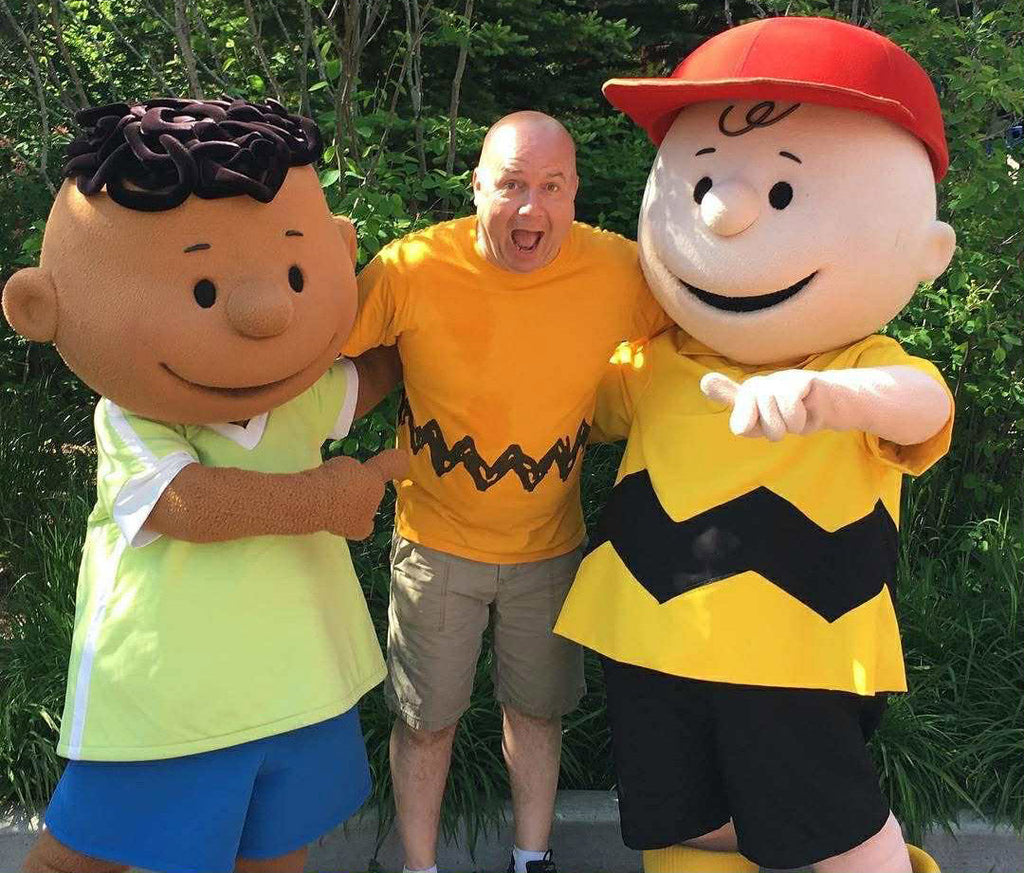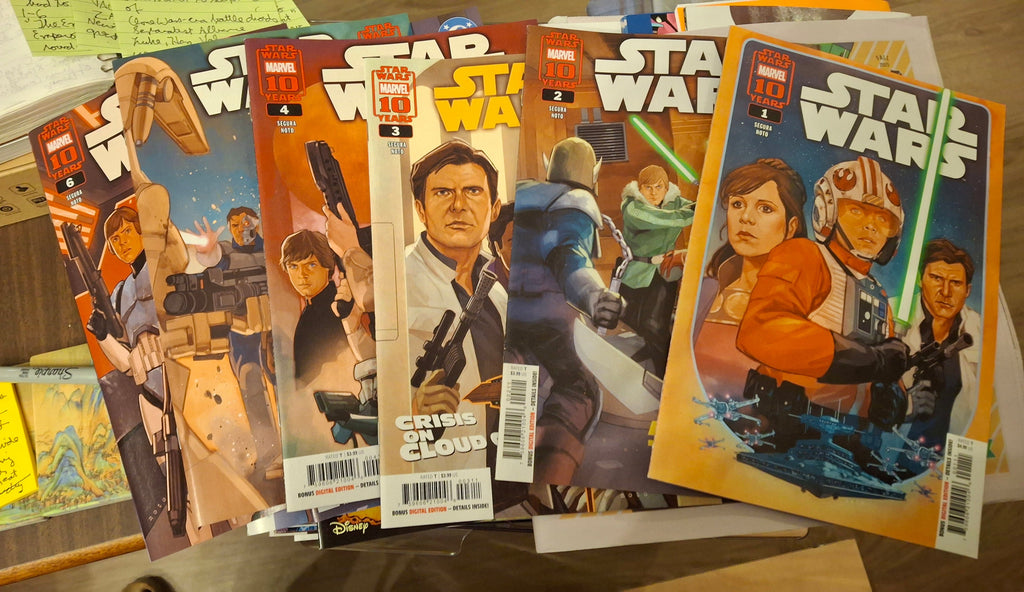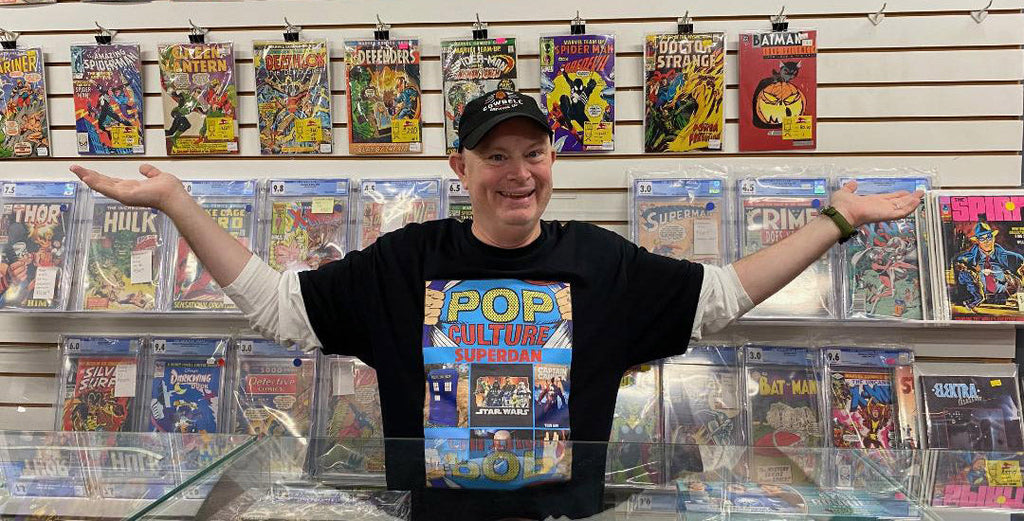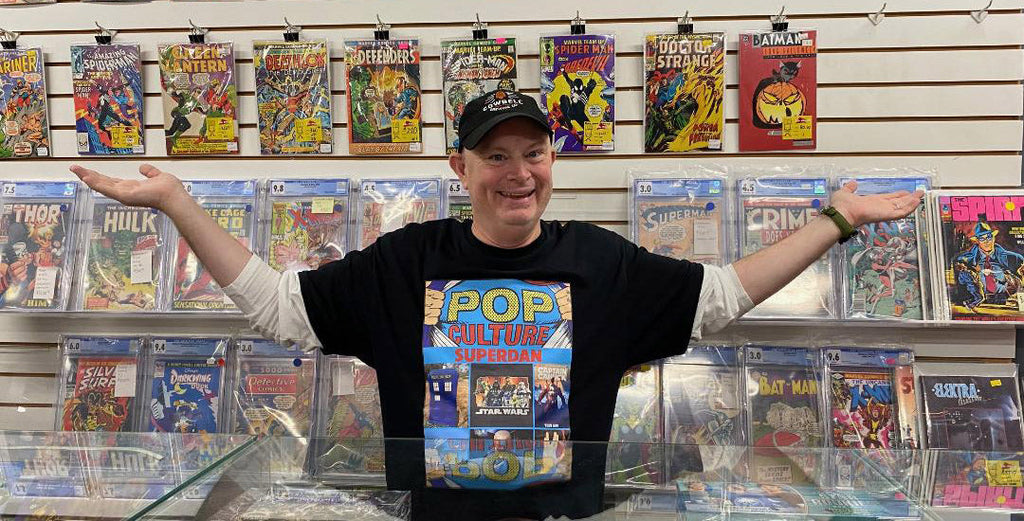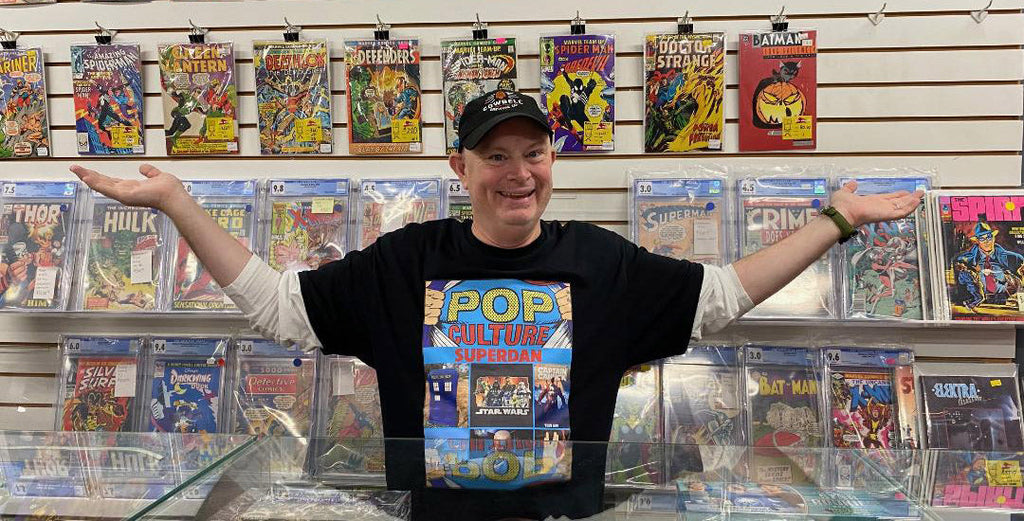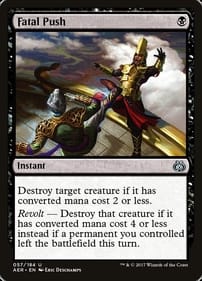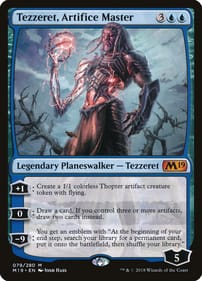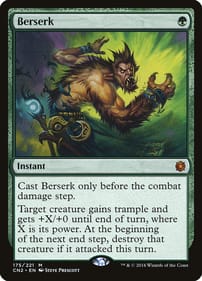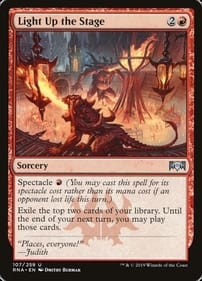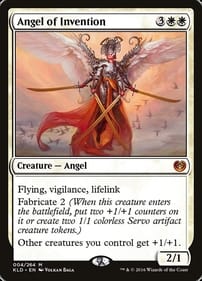My Favourite Bad Guy
By Dan Brown It was a turning point in my thinking about pop culture. I was eight years old when Star Wars came out in 1977. My friends and I lived, breathed, played, talked about that movie all the time in the schoolyard. Once, when discussing our favourite characters, one friend – who was two years older – mentioned something that rocked my world. He said his favourite Star Wars character was Darth Vader. I had trouble wrapping my head around his answer. Wait a second, he likes . . . . the villain? Did I hear that right? It had never occurred to boyhood me that you could side with the dark side. It had never entered my mind that you could judge a movie bad guy to be cooler than the good guy. I mean, Luke Skywalker is the hero, right? So what is this talk about Darth Vader being awesome? I mean, he’s out to get Luke and stop the galactic rebellion. Vader is the one who strangles people – with his hands or with the Force. He’s the guy who defeats Ben Kenobi. He tries to shoot Luke down in the Death Star trench. He wears black, for crying out loud! How could you dig somebody like that? So you can see how this would have been a revolutionary idea at the time. One of the reasons for the success of Star Wars in 1977 was how, in the shadow of Watergate and the Vietnam War, it brought back clearly defined heroes and villains. Even a morally grey figure like Han Solo has a change of heart and forsakes his mercenary ways at the end of the film, revealing his inner goodness. In 2025, of course, this is not at all a crazy idea. We long ago gave up expecting our heroes and those who opposed them to be inherently good or evil. One of the biggest Star Wars fan groups is the 501st Legion, who dress up as stormtroopers, the foot soldiers who carry out Vader’s diabolical plans. So my childhood friend is not the only person who’s into the Empire. And I can admit my friend is right: Darth Vader is more interesting than Luke, who turns out to be his son. What my older friend said back then shaped my thinking about villains. So when the second movie in the trilogy came out in 1980, I was astounded at how cool the Imperials walkers were. My friend had expanded my horizons. He had given me permission to think about all the characters and where they were coming from. My black-and-white world was now in full colour. Dan Brown has covered pop culture for more than 33 years as a journalist and also moderates L.A. Mood’s monthly graphic-novel group.
Same Great Cosplay, New Venue for Forest City Comicon
By Dan Brown No, that’s not me in the photo above – it’s another bald, middle-aged white nerd. The guy in the sawtooth Charlie Brown shirt is Ian Tyson. Like me, he’s a huge fan of pop culture, including such superheroes as Superman – Tyson has already seen this summer’s movie about the Man of Steel five times! Tyson is also. one of the key organizers for Forest City Comicon. If you attend the annual celebration of all things geeky this Sunday, you’ll likely see him hosting panel discussions. The timing for F3C this year – two days after Halloween – is no accident, he tells me via Facebook message. “It’s one of the reasons we chose this particular weekend at (Best Western Lamplighter Inn), with the notion being this Halloween, keep your costume on,” he explained. “I think Halloween has turned into more than just a day. It’s a whole weekend. So why not continue the celebration right into Sunday?” Forest City Comicon has always had a thriving cosplay scene. Tyson isn’t sure the exact reason. “We have a lot of great connections with our board to the cosplay community and that may certainly play a part in it. (The con) draws out really great creators and artists and people who just make incredible costumes,” he added, noting the afternoon cosplay contest attracts “everybody from the masterful ones to the little kids that are trying it out for the first time.” One outfit that stands out in his memory is from 2017, when one attendee dressed up as DC’s Hawkgirl. “She stood on stage and extended the (retractable) wings to their full span, which was significant!” Tyson recalled. “It was really incredible.” Tyson has been involved with every Forest City Comicon since it launched in 2014 at Centennial Hall. With the shift to the Lamplighter, this Sunday will be the first F3C to be held outside of downtown London. “The event features special guests, costumes, artists, exhibitors, board games, video-game tournaments, panel presentations, and more,” Tourism London boasts of the one-day show. “We’re very excited at the prospects of what’s gonna happen this year at the Lamplighter. I think the vibe will be lighter and more fun. It’s warm. It feels like summertime in there, and it’s just a great space,” Tyson said. “I think that we truly have something for everyone, and have put a really great show together this year.” Something that has been a staple of past editions of Forest City Comicon is to bring in not only actors, but also celebrity guests other than those with familiar faces. Sure, there have been performers like 2017’s Billy Boyd, who played Pippin the Hobbit in the Lord of the Rings movies. But also part of the meat-and-potatoes for Forest City Comicon have been the talented individuals who fill out the crew and cast of motion pictures and TV franchises, like voice actor Billy West, who came to London in 2016. This Sunday will see a visit by David Barclay, the puppeteer who helped bring Star Wars characters such as Yoda the Jedi Master and Jabba the Hutt to life. Barclay is also known for “all things Muppet,” Tyson says. Oh yeah, and Cocaine Bear is coming, too! That would be Alan Henry, the motion-capture artist who played the titular coked-out beast two years ago. He’s also played King Kong, as well as characters in the Marvel, DC, Avatar, Lord of the Rings, and Minecraft universes. “From our experience doing these cons, motion-capture actors are fantastic guests that have great stories,” Tyson said, adding mo-cap performers “have stories to tell. They have been on the sets of these big things that we love, major projects, and been there doing the heavy lifting.” “Plus, what I have found is they all very much seem to be fans of the work they are doing. They are into it and they love meeting fans of that work, too. It makes for great back-and-forth interactions. They are just good people and are a lot of fun.” You will also see me at Forest City Comicon on Sunday. But don’t worry, folks, I won’t feed the Cocaine Bear! Dan Brown has covered pop culture for more than 33 years as a journalist and also moderates L.A. Mood’s monthly graphic-novel group.
New Star Wars Series Aimed at Fans
By Dan Brown Dedicated fans will get the most of out Marvel’s ongoing Star Wars title featuring Luke Skywalker, Han Solo, and Princess Leia. I would say I’m a fan of Star Wars, the Empire Strikes Back, and the first third of Return of the Jedi, so I enjoyed it just fine. This series – I looked at the first six issues – takes place in the timeline after the end of Return of the Jedi, with the Empire in tatters and our plucky bunch of heroes attempting to bolster the fledgling New Republic. There are all the usual trappings: blasters firing, lightsabres slicing, spaceships exploding, treaties being negotiated. (No one gets choked, though, which happens a lot in those original movies.) What will jump out at fans is how characters show up who have never been featured in a Star Wars movie. So the story – which revolves around Princess Leia wooing a system of planets to join her incipient interstellar government – has Solo teaming up with Valance, a bounty hunter who made his debut in Star Wars comics way back in 1978. Shades of Darth Vader, he was a self-loathing cyborg. Here, after he and Solo escape from a tight spot, the pair of rogues enjoy drinks at an alien-infested tavern. This is when Valance gives the Corellian a hard time for becoming part of the rebel establishment. “Things are different now, Valance. I can’t just hop in the (Millennium) Falcon and fly off on an adventure whenever I like,” the one-time smuggler and now married man explains. “The old days are gone.” What will also stand out for longtime fans is how the characters actually resemble the actors who portrayed them in the original trilogy — so Solo looks like Harrison Ford, Skywalker like Mark Hamill, and so on. Back in the day, the licence Marvel had with Lucasfilm stipulated that they couldn’t do this, in case George Lucas ever needed to re-cast any of the roles. What fans of those original comics got were bland, anonymous characters who had roughly the same hairstyle as the ensemble that made the movies such a sensation. It’s unclear how much of the interregnum between Return of the Jedi and The Force Awakens will be covered in the new series. And that’s part of the problem: Because there is so much plot infrastructure already in place, there’s only so many directions writer Alex Segura and artist Phil Noto can go. The result: The creative team is constrained in bringing real change to the existing universe (these comics are billed as canon, though). They can’t kill off a main character, for instance. Still, Luke does get to Force-shove some baddies out his way and fire up his laser sword. Solo does get to shoot his way back to his hunk of junk spaceship through a crowd of villains. And Leia does get hot-headed during some palace intrigue. If that sounds like fun, this is the series for you. By the way, I’m also a fan of the Last Jedi, the Mandalorian, Rogue One, Andor, and the standalone Solo movie. Now there’s an idea – since Solo: A Star Wars Story is unlikely to ever get a sequel on the big screen, why not have a comic series that details what happens to Han and Chewie in the decade before they meet Luke and Ben Kenobi on Tatooine? That would be something I could really get behind! Dan Brown has covered pop culture for more than 33 years as a journalist and also moderates L.A. Mood’s monthly graphic-novel group.
Pop Culture Like Star Trek Used to be Disposable Fluff
By Dan Brown When I say “Star Trek,” I mean the old TV show that featured William Shatner as Captain Kirk and Leonard Nimoy as Mister Spock. I don’t mean the Next Generation or Voyager or Upper Decks or Strange New Worlds or anything else. And if you’ve seen a Star Trek rerun in the last few years, you’ll have noticed the special effects stand up remarkably well. Although it was made on a shoestring budget in the late 1960s for an audience that had low expectations of science-fiction television, those shots of the Enterprise look crisp. But here’s the thing: Those aren’t the original effects. When you see the Enterprise floating in space, fighting a battle, or high above a planet’s surface, those images were inserted into the original episodes in a remastering process that dates back only to 2006. So the Trekkies who fell in love with the series in the 1960s did so without the attraction of modern special effects. My purpose here isn’t to argue which version is better. Nor is it to speculate if Star Trek creator Gene Roddenberry would have approved of the new effects (he died in 1991). What I want to point out is how the revised Star Trek episodes represent a new attitude toward pop culture. What would surprise Roddenberry if he were alive is how long-lived his show has been. When the program originally aired from 1966 to 1969, TV didn’t have a great reputation. The medium was derided as “the boob tube” because the dominant perception was that the small screen appealed to those who weren’t all that bright. Consequently, Star Trek – which many consider classic stuff today – was just as disposable as any other show on the air at the time. In other words, despite embodying enduring social and political themes, individual episodes weren’t built to last. It didn’t matter back then if the show would hold up to repeated viewings, and I’m guessing the idea people would still be watching Star Trek in the year 2025 would have startled network executives. Nor is Star Trek the only example of pop culture that was created as ephemera that has far outlasted its creator’s intentions. Star Wars (by which I mean the movie with that title that came out in 1977) was made at a moment when few moviegoers were willing to pay to see a particular film multiple times. After all, a child’s ticket went for a whopping $1.50! Who could afford that in the hardscrabble Seventies, no matter how much you loved a film? As you likely know, several new coats of digital paint have been applied to Star Wars in the interim. There were versions with enhanced sound effects, then versions with enhanced visual effects, and on and on. They may have even released a 3D Star Wars for all I know. It doesn’t stop there. There are also updated editions – with outtakes put back in – of novels like George Orwell’s Nineteen Eighty-Four and Stephe King’s ’Salem’s Lot. Albums such as Bob Marley’s Legend have likewise been retouched. The important thing to note here is our feelings about pop culture like the original Star Trek series have changed: What was once a throwaway indulgence meant only for a moment’s pleasure is now taken seriously, even expected to transcend its time. Heck, there are even such journalists as Rob Salkowitz who specialize in writing about pop culture! That didn’t used to happen. Expectations have risen dramatically. You could even argue it’s pop culture like Star Trek and Star Wars that is partly responsible for creating an audience that wants more out of its TV, movies, music and so on, than a momentary distraction. Me, I prefer the “original” versions of things that were released back in the day. To my eyes, the first Star Wars motion picture had a certain low-budget charm so I didn’t need a new, “better” one. But I’m glad it’s still around, even in a modified form, to light the fire of imagination in the minds of a new generation of pop-culture enthusiasts who have higher expectations than I ever did. Dan Brown has covered pop culture for more than 32 years as a journalist and also moderates L.A. Mood’s monthly graphic-novel group.
Pop Culture Like Star Trek Used to be Disposable Fluff
By Dan Brown When I say “Star Trek,” I mean the old TV show that featured William Shatner as Captain Kirk and Leonard Nimoy as Mister Spock. I don’t mean the Next Generation or Voyager or Upper Decks or Strange New Worlds or anything else. And if you’ve seen a Star Trek rerun in the last few years, you’ll have noticed the special effects stand up remarkably well. Although it was made on a shoestring budget in the late 1960s for an audience that had low expectations of science-fiction television, those shots of the Enterprise look crisp. But here’s the thing: Those aren’t the original effects. When you see the Enterprise floating in space, fighting a battle, or high above a planet’s surface, those images were inserted into the original episodes in a remastering process that dates back only to 2006. So the Trekkies who fell in love with the series in the 1960s did so without the attraction of modern special effects. My purpose here isn’t to argue which version is better. Nor is it to speculate if Star Trek creator Gene Roddenberry would have approved of the new effects (he died in 1991). What I want to point out is how the revised Star Trek episodes represent a new attitude toward pop culture. What would surprise Roddenberry if he were alive is how long-lived his show has been. When the program originally aired from 1966 to 1969, TV didn’t have a great reputation. The medium was derided as “the boob tube” because the dominant perception was that the small screen appealed to those who weren’t all that bright. Consequently, Star Trek – which many consider classic stuff today – was just as disposable as any other show on the air at the time. In other words, despite embodying enduring social and political themes, individual episodes weren’t built to last. It didn’t matter back then if the show would hold up to repeated viewings, and I’m guessing the idea people would still be watching Star Trek in the year 2025 would have startled network executives. Nor is Star Trek the only example of pop culture that was created as ephemera that has far outlasted its creator’s intentions. Star Wars (by which I mean the movie with that title that came out in 1977) was made at a moment when few moviegoers were willing to pay to see a particular film multiple times. After all, a child’s ticket went for a whopping $1.50! Who could afford that in the hardscrabble Seventies, no matter how much you loved a film? As you likely know, several new coats of digital paint have been applied to Star Wars in the interim. There were versions with enhanced sound effects, then versions with enhanced visual effects, and on and on. They may have even released a 3D Star Wars for all I know. It doesn’t stop there. There are also updated editions – with outtakes put back in – of novels like George Orwell’s Nineteen Eighty-Four and Stephe King’s ’Salem’s Lot. Albums such as Bob Marley’s Legend have likewise been retouched. The important thing to note here is our feelings about pop culture like the original Star Trek series have changed: What was once a throwaway indulgence meant only for a moment’s pleasure is now taken seriously, even expected to transcend its time. Heck, there are even such journalists as Rob Salkowitz who specialize in writing about pop culture! That didn’t used to happen. Expectations have risen dramatically. You could even argue it’s pop culture like Star Trek and Star Wars that is partly responsible for creating an audience that wants more out of its TV, movies, music and so on, than a momentary distraction. Me, I prefer the “original” versions of things that were released back in the day. To my eyes, the first Star Wars motion picture had a certain low-budget charm so I didn’t need a new, “better” one. But I’m glad it’s still around, even in a modified form, to light the fire of imagination in the minds of a new generation of pop-culture enthusiasts who have higher expectations than I ever did. Dan Brown has covered pop culture for more than 32 years as a journalist and also moderates L.A. Mood’s monthly graphic-novel group.
New Star Wars Comic for Fans Only
By Dan Brown Although it’s well-made, Star Wars: A New Legacy No. 1 will likely appeal mostly to diehard fans of the interstellar epic. If you’re a devotee of characters like Valance, Black Krrsantan and Doctor Aphra, this is the comic for you. The presence of heroes from the movies – Luke Skywalker, Princess Leia, Han Solo – is felt here, but those old favourites aren’t actually part of the action. Instead, this comic contains a trio of tales which were created as vehicles for minor players in Marvel’s Star Wars universe. As Marvel begins a new phase of its Star Wars offerings, they’ve been promoted. Some members of this introductory issue’s cast have a long history. Valance, for instance, originated way back in 1978 in Star Wars No. 16. He was introduced as a self-loathing cyborg, which seemed to be a Marvel specialty back then – the publisher also had Deathlok on its roster in those days. This was years before Star Wars fans got a peek under Darth Vader’s helmet in The Empire Strikes Back. However, there’s no sign of Jaxxon, the giant green alien rabbit, who has gone from being a bad joke to beloved by fans. Hey, if people today can openly express their love for Jar-Jar Binks, then anything’s possible. Marvel got the rights to print Star Wars comics when the original movie debuted in 1977. It was an astute move, as some observers credit that title alone for keeping the company solvent in a financially precarious era. It’s hard to believe now, but over the decades the space fantasy’s appeal faded, so Dark Horse Comics eventually became the official headquarters for Star Wars comics. When Disney brought Marvel under its corporate umbrella, the licence soon reverted back to the House of Ideas. In the first section of A New Legacy, Valance appears on the trail of Doctor Aphra.For years, I wanted to see a Disney+ series featuring Aphra, but my prediction that the gonk droid would get a show before the rogue archeologist seems less and less like hyperbole as Aphra continues to go unloved by the Star Wars brain trust. Even one of her sidekicks, the wookiee called Black Krrsantan, made the leap to the small screen in the Book of Boba Fett without Aphra. She also appears in the back-of-the-book section in a story that inverts the old saying about letting the wookiee win at holographic chess. It turns out that advice doesn’t apply when one of the big, shaggy aliens is playing against a murder robot: “Let the droid win.” Sandwiched between those two stories is a narrative about the Empire’s Scar Squadron, who are also known as Task Force 99. This tale has a slight flavour of the Wild Bunch in that these stormtroopers are men out of time – they embody everything Imperial at a moment when the Rebellion is on the rise. They can’t understand why the crowds that used to cheer them want to rise up at the urging of rebel scum they consider terrorists. “We bring order, while all they have to offer this galaxy is chaos,” their sergeant laments in his inner monologue. This means the white-armoured soldiers – who operate on the outer rim of the outer rim – are on their way to becoming like the U.S. commander in Vietnam who famously said, “It became necessary to destroy the town to save it.” These grunts are on their way to setting fire to the universe so they can preserve it.Every Star Wars buff has their own favourite obscure characters from the vast universe created by George Lucas. If the one’s I’ve mentioned here are among yours, then you’ll enjoy A New Legacy. If not, you’ll want to give it a miss. Dan Brown has covered pop culture for more than 32 years as a journalist and also moderates L.A. Mood’s monthly graphic-novel group.



